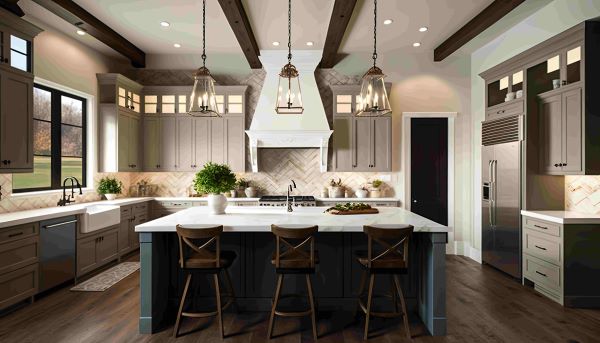The growing impact of artificial intelligence (AI) is increasingly felt across various industries, and interior design is no exception. AI tools are changing the way spaces are organised, offering innovative solutions that make it easier to achieve both functionality and aesthetic appeal. Traditionally, interior design was limited by human expertise, taste, and the available technology. But with the rise of AI, it’s now possible to design and organise spaces more efficiently than ever before.
How AI Interior Design Works
AI-driven interior design tools provided by Onton and others have become indispensable for individuals and businesses alike. They provide unique capabilities that were previously unavailable, helping users visualise and implement design solutions faster and more accurately.
AI interior design tools utilise machine learning algorithms and databases filled with an extensive range of design solutions, colour schemes, furniture arrangements, and layout plans. These tools analyse the user’s specific space, needs, and preferences to recommend design options that fit seamlessly. They can even simulate different lighting conditions and predict how various elements will interact within a room.
By leveraging machine learning and vast datasets of design styles and layouts, AI helps create customised interiors tailored to specific preferences and space constraints. Additionally, these tools incorporate key principles of ergonomics and space optimisation, ensuring that every square foot is used to its maximum potential.
Efficiency and Time-Saving
One of the most significant advantages of AI interior design tools is increasing productivity in terms of how much time they save. Instead of spending hours or even days brainstorming design ideas or consulting with a professional, users can get immediate suggestions tailored to their specific needs. AI tools can analyse thousands of design possibilities in seconds, providing the most efficient and aesthetically pleasing options almost instantly.
Personalization and Customisation
AI systems are designed to learn from user input. This means they can generate design suggestions based on individual tastes, preferences, and requirements. For example, AI can remember that a user prefers minimalist furniture styles or a particular colour palette. As a result, each design is uniquely tailored, making the entire process feel highly personal and customised.
Maximizing Space Efficiency
AI-driven design tools can be invaluable for smaller living spaces because these systems are adept at suggesting layouts and furniture arrangements that optimise the available space. Whether dealing with tight corners, awkwardly shaped rooms, or limited square footage, AI can ensure that every area is used efficiently.
Budget-Friendly Solutions
AI tools can also consider budget constraints when recommending design solutions. Many platforms allow users to input their budget, and the system will generate cost-effective design ideas. This is especially useful for individuals or businesses looking to enhance their spaces without overspending.
Real-Time Visualisation
One of the key features of AI in interior design is the ability to visualise changes in real time. Users can move furniture, adjust colours, or even switch lighting schemes within the AI platform and immediately see how these changes will look in their actual space. This instant feedback eliminates guesswork, ensuring that the final result matches the user’s expectations.
Sustainability and Eco-Friendly Design
AI tools also offer solutions for those looking to incorporate sustainable design practices. These platforms can suggest materials, furniture, and layouts that are not only aesthetically pleasing but also environmentally friendly. AI can recommend energy-efficient lighting options, sustainable materials, and layouts that maximise natural light, reducing the need for artificial lighting.
How AI Enhances Design Collaboration
In traditional interior design, collaboration between designers, architects, and clients can sometimes be a time-consuming process. However, AI simplifies collaboration by providing a digital platform where all parties can view, adjust, and approve designs in real time. This streamlines communication, ensuring that everyone involved in the project is on the same page.
AI-powered tools also allow for easy sharing of design ideas with friends, family, or business partners. With just a few clicks, users can send design proposals or ask for feedback, making the entire process more interactive and engaging. These collaboration features are especially beneficial for large-scale design projects where multiple stakeholders are involved.
Future Trends in AI Interior Design
As AI technology continues to evolve, the future of interior design will likely see even more sophisticated tools and features. AI is expected to integrate more seamlessly with other emerging technologies such as virtual reality (VR) and augmented reality (AR), allowing users to “walk through” their newly designed spaces before making any physical changes.
Conclusion
The integration of AI in interior design is transforming the way spaces are organised and optimised. The ability to visualise designs in real time, maximise space, and incorporate sustainable practices only adds to the growing appeal of AI in this field. As technology continues to advance, AI-driven interior design is poised to become an essential part of creating organised, efficient spaces that meet the needs of modern living and working environments.

